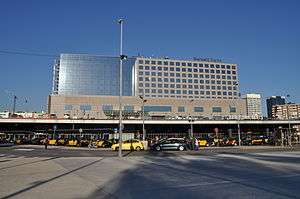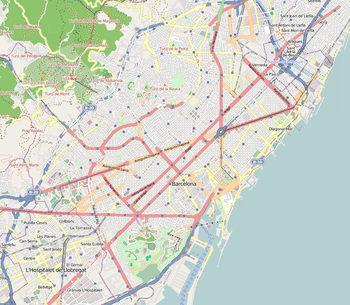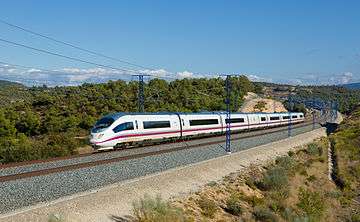Barcelona Sants railway station
Barcelona Sants is the main railway station in Barcelona, owned by Adif, the railway infrastructure agency of Spain. It has become the most important transport hub of the city - being the centre of Rodalies de Catalunya including Barcelona suburban railway services and regional services, as well as the main inter-city station for national and international destinations. The station is named after Sants, the neighbourhood of Barcelona in which it is located. New parts of the station have recently been remodeled to accommodate the Spanish high-speed train AVE in the city, which started serving the city on 20 February 2008. There is also an adjacent international bus station bearing the same name, and a link to the Sants Estació metro station that serves the railway station.
Barcelona Sants | |
|---|---|
 The station's main façade in 2008 | |
| Location | Plaça dels Països Catalans 08014 Barcelona Spain |
| Coordinates | 41°22′44″N 2°08′24″E |
| Owned by | Adif |
| Operated by | Renfe Operadora and SNCF |
| Line(s) |
|
| Platforms | 7 island platforms |
| Tracks | 14 — 8 in Iberian gauge and 6 in standard gauge |
| Connections |
|
| Construction | |
| Structure type | Underground |
| Platform levels | 2 |
| Parking | Adjacent parking garage. |
| Disabled access | Yes |
| Other information | |
| Station code | 71801 (Adif) |
| IATA code | YJB |
| History | |
| Opened | July 18, 1975 |
| Traffic | |
| Passengers (2018) | 46,511,388 ( |
| Rank | 2[2] |
| Location | |
 Barcelona Sants Location in Barcelona  Barcelona Sants Location in Spain | |
History and architectural design
The modern Sants station was built in the 1970s as part of construction of the second east-west regional line running under the centre of Barcelona. The first east-west railway to Estació de França terminus, more to the north,[3] was covered up and is now also in use as a railtunnel for the regional and long distance trains. Over the last 30 years, Estació de Sants has since eclipsed the earlier França terminus (Barcelona Estació de França), from the 1920s, as Barcelona's main railway station.
The station was built in a modern airport style, with all of its many platforms sited underground. A hotel (Hotel Barceló Sants) occupies most of the upper floors of the station's main building.
Location

The station is in the Sants-Montjuïc district of Barcelona, a little way to the west of the city centre, and is easily accessible via metro (see section below) or bus from anywhere in the city. Sited at the end of Avinguda Roma between two squares, Plaça dels Països Catalans and Plaça Joan Peiró, it has two entrances, one in each.
Services
Long distance
Madrid is two and a half hours away on the AVE Madrid-Barcelona high-speed rail line, after the link between Camp de Tarragona and Barcelona opened in 2008. Extension of the high-speed network east into France connecting with the TGV network was completed in January 2013 upon completion of the Perpignan–Barcelona high-speed rail line and a direct TGV service started in December 2013.[4][5] The high speed service uses platforms 1 to 6, which have now been converted to the European standard gauge for use by the AVE services, unlike the remaining 8 for other RENFE services using the wider Spanish gauge tracks. A second major railway station in Barcelona, Estació de la Sagrera, currently under construction, is expected to join it in order to provide a wider access to high-speed and long distance train to the north of the city.
| Preceding station | Renfe Operadora | Following station | ||
|---|---|---|---|---|
toward Madrid Puerta de Atocha | AVE | Terminus | ||
| AVE | toward Figueres-Vilafant |
|||
toward Seville-Santa Justa | AVE | Terminus | ||
toward Málaga María Zambrano | AVE | |||
| Terminus | AVE | toward Lyon-Part-Dieu |
||
| AVE | toward Toulouse-Matabiau |
|||
Terminus | AVE | toward Marseille-St-Charles |
||
toward Bilbao Abando | Alvia | Terminus | ||
toward Hendaye | Alvia | |||
toward A Coruña | Alvia | |||
toward Vigo-Guixar | Alvia | |||
toward Gijón | Alvia | |||
| Tarragona toward Valencia Nord |
Alaris | Terminus | ||
| Tarragona toward Alicante |
Alaris | |||
Tarragona toward Valencia-Joaquín Sorolla | Euromed | Barcelona Estació de França Terminus |
||
Tarragona toward Alicante | Euromed | Terminus | ||
| Tarragona toward Alicante |
Talgo | Terminus | ||
| Tarragona toward Murcia del Carmen |
Talgo | Terminus | ||
| Tarragona toward Cartagena or Lorca-Sutullena |
Talgo "Mare Nostrum" | Terminus | ||
| Tarragona toward Seville-Santa Justa |
Talgo "Torre del Oro" | Barcelona Estació de França Terminus | ||
| Camp de Tarragona toward A Coruña or Vigo-Guixar |
Trenhotel "Galicia" | Terminus | ||
| Preceding station | SNCF | Following station | ||
| Terminus | TGV | toward Paris-Lyon |
Regional and commuter rail
| Preceding station | Renfe Operadora | Following station | ||
|---|---|---|---|---|
toward Lleida Pirineus | Avant | Terminus | ||
toward Tortosa | Avant | Terminus | ||
| Terminus | Avant | toward Figueres-Vilafant |
||
| Camp de Tarragona toward Valladolid-Campo Grande |
Intercity | Terminus | ||
| Camp de Tarragona toward Pamplona |
Intercity | |||
| Tarragona toward Valencia Nord |
Intercity | |||
Sant Vicenç de Calders toward Zaragoza-Delicias | Media Distancia 34 | Barcelona Passeig de Gràcia toward Barcelona Estació de França |
||
| Preceding station | Following station | |||
L'Hospitalet de Llobregat toward Molins de Rei | R1 | toward Maçanet-Massanes |
||
toward Castelldefels | R2 | toward Granollers Centre |
||
toward Barcelona–El Prat Airport | R2 Nord | toward Maçanet-Massanes |
||
toward Sant Vicenç de Calders | R2 Sud | toward Barcelona Estació de França |
||
L'Hospitalet de Llobregat Terminus | R3 | toward Latour-de-Carol-Enveitg |
||
L'Hospitalet de Llobregat toward Sant Vicenç de Calders | R4 | toward Manresa |
||
L'Hospitalet de Llobregat Terminus | RG1 | toward Portbou |
||
| Terminus | R11 | toward Cerbère |
||
L'Hospitalet de Llobregat Terminus | R12 | toward Lleida Pirineus |
||
Gavà toward Lleida Pirineus | R13 | toward Barcelona Estació de França |
||
Gavà toward Lleida Pirineus | R14 | |||
toward Riba-roja d'Ebre | R15 | |||
Vilanova i la Geltrú toward Ulldecona-Alcanar-La Sénia or Tortosa | R16 | |||
Vilanova i la Geltrú toward Port Aventura | R17 | |||
| Suspended | ||||
toward Barcelona–El Prat Airport | R10 | toward Barcelona Estació de França |
||
Barcelona Metro
References
- "Adif - Información de estaciones - Barcelona Sants". ADIF. Retrieved 3 September 2019.
- "Atocha Cercanías lidera las estaciones de tren en España con más de 270.000 viajeros al día". Tribuna de Salamanca (in Spanish). 3 April 2019. Retrieved 2 September 2019.
- railwaymap 1908 The square in front of the station is situated at 'Carres de Tarragona' also visible on the map.
- "High speed line opens between Barcelona and Figueres". Railway Gazette International. 8 January 2013.
- Communiqué de presse Paris - Barcelone
External links
| Wikimedia Commons has media related to Barcelona-Sants train station. |
- Barcelona Sants listing at Adif website
- Barcelona Sants listing at Rodalies de Catalunya website
- Information and photos of the station at Trenscat.com (in Catalan)
